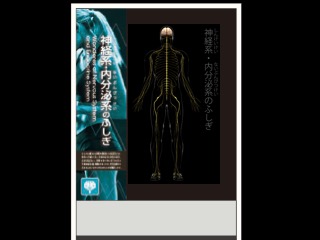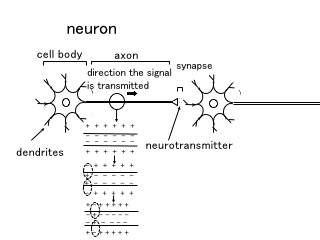Nagoya City Science Museum
TOP > Exhibition Guide > Keyword Search > Starting with "S" > synapse > Wonders of Nervous System and Endocrine System
Wonders of Nervous System and Endocrine System



Purpose of Exhibition
The nervous system that regulates body movement and the senses consists of peripheral nerves system (motor nerves, autonomic nerves, and sensory nerves) close to muscles and internal organs, and the central nervous system that controls the nervous system by receiving information and sending orders. Hormone excreted from endocrine glands regulates the body's functions with small amount of hormone.
This exhibit presents the basics about of the nervous system and endocrine system through movie and three pieces of information about each on the reverse side.
Additional Knowledge
The nervous system, which features a specialized type of cells called "neurons," functions to perceive "what's going on" outside and inside the body, such as "I touched something cold" and "This material is in short supply."
[The central nervous system and peripheral nervous system]
The central nervous system is divided into the brain and the spinal cord, and sends out commands to specific peripheral nerves and receives information from them.
The peripheral nervous system is divided into 4 groups.
- Somatic nervous system
Sensory nerves: They convey information from sensory organs such as eyes, ears, nose, tongue, and skin and other organs.
Motor nerves: They move muscles.
- Autonomic nervous system
Autonomic nervous system: Controls internal organs (the sympathetic nervous system works when people get tension and excitement; the parasympathetic nervous system works when people get rest or after meals).
[Function of Central Nervous System]
A spinal animal (backboned animal) has the vertebral column-housed portion of its central nervous system along the back muscles. This particular portion is called "spinal cord".
The upper end of the spinal cord is roundly enlarged and part of the brain, which is divided into the cerebrum, midbrain, cerebellum and diencephalon. Between the brain and spinal cord is the medulla oblongata, which serves as the respiration and reflection center.
The brain and spinal cord have specific parts for receiving specific senses and sending orders.
- Cerebrum: The organ associated with humanity more than other organs, and works differently depending on the parts
- Cerebellum: Controls body movements
- Diencephalon: Relays sensory nerves, and is the center of the autonomic nervous system and the endocrine system
- Brain stem (midbrain/pons/medulla oblongata): Involved in maintaining life
- Spinal cord: Controls reflexes and acts as a relay for each part of the brain
[Autonomic Nervous and Endocrine System]
While we are asleep or under the unexpected circumstances, we have little or no time to think about something to make a response. The autonomic nervous system and endocrine system automatically adapt the bodily condition to internal and external changes. These two systems collaborate with each other to keep the body in comfortable condition. The control center for these systems is located in the hypothalamic region of the diencephala.
[Sympathetic Nervous System and Parasympathetic Nervous System]
We have no control over the function of the autonomic nervous system, which divides into the sympathetic nervous system and parasympathetic nervous system according to function, location and characteristic. Both systems are mostly distributed in the same organs but perform opposite functions. (Briefly, the sympathetic nervous system vitalizes the body’s functions and the parasympathetic nervous system relaxes the body.) They command the organs by releasing neurotransmitters ‐ noradrenaline (partly acetylcholine) and acetylcholine respectively.
[Endocrine System]
The endocrine system is formulated to release chemical substances into the bloodstream and transport them to the tissues and organs throughout the body. The chemical substances are called "hormones", even very small amounts of which have a major effect on the body.
Hormones come in a variety of types. Included in the endocrine system is a "feedback" system to regulate (promote or control) the secretion of hormones by itself and/or in collaboration with other types of hormones and/or with the autonomic nervous system. With regard to the types and functions of hormones, many reference data and textbooks are available and we suggest that you refer to them.
[Nerve Cell called "Neuron"]
The nervous system is the exclusive system formulated to let the entire body perceive "what's going on" outside and inside the body.
What plays the leading role in the nervous system is a nerve cell called "neuron" whose shape and function are one of a kind.
The nerve cell has a number of prickles on its surface, which are called "dendrites". Each dendrite looks like a tree branch. That is why it is so called. One of the dendrites on a neuron is so long and it is called "axon," which is also called "nerve fiber" for its thread-like shape.
[Neuron's Function]
When one of those neurons receives a signal (information) from one of its dendrites, the neuron transmits the signal electrochemically through its axon to its neighboring neurons.
Inside a "neuron", electrical signals are conducted from the cell body to the tip of the axon. This is called nerve conduction. In vertebrate animals, the axons are covered with "a myelin sheath". This speeds up the transmission of information compared to axons without myelin.
On the other hand, what does the "synapse" show us? In the "synapse", signals are transmitted from one "neuron" (a presynaptic cell) to another cell (postsynaptic cell, which is a "neuron" or the cell of a muscle or organ). There is a micro gap called "synaptic cleft" between the two cells which is smaller than one ten thousandth of a millimeter.
"Neurotransmitters" are released from the presynaptic cell into a synaptic cleft. They transmit information.
When the signal arrives at the terminal of the axon, a substance called "neurotransmitter" is transmitted to the neighboring neurons. The neurotransmitter varies in type and amount according to the type of the neuron and occasion, and is formulated to transmit complex signals ingeniously to the neighboring neurons.
Once the "neurotransmitters" reach a postsynaptic cell, electrical signals are generated and conducted through to an axon. Although the synaptic cleft is a narrow gap, it never transmits information in a reverse direction from a postsynaptic cell to a presynaptic cell.
In this way, there are two ways nerves can transmit information: conduction (electrical) within a cell and transmission (substance) to a neighboring cell.
Article and illustrations by Tomoko Horiuchi, curator
